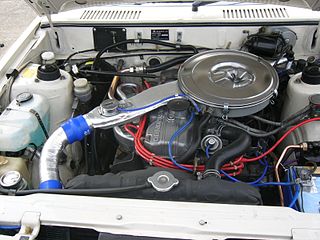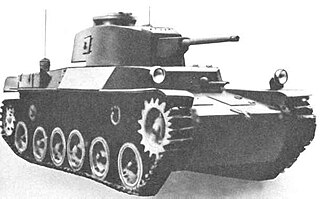
This is a list of engines and weapons used on Japanese tanks during World War II .

This is a list of engines and weapons used on Japanese tanks during World War II .




The radial engine is a reciprocating type internal combustion engine configuration in which the cylinders "radiate" outward from a central crankcase like the spokes of a wheel. It resembles a stylized star when viewed from the front, and is called a "star engine" in some other languages.

The Mitsubishi Astron or 4G5/4D5 engine, is a series of straight-four internal combustion engines first built by Mitsubishi Motors in 1972. Engine displacement ranged from 1.8 to 2.6 litres, making it one of the largest four-cylinder engines of its time.

The Mitsubishi Sirius or 4G6/4D6 engine is the name of one of Mitsubishi Motors' four series of inline-four automobile engines, along with Astron, Orion, and Saturn.

The Mitsubishi 4G9 engine is a series of straight-4 automobile engines produced by Mitsubishi Motors. All are 16-valve, and use both single- and double- overhead camshaft heads. Some feature MIVEC variable valve timing, and it was the first modern gasoline direct injection engine upon its introduction in August 1996.

The 6G7 series or Cyclone V6 engine is a series of V6 piston engines from Mitsubishi Motors. Five displacement variants were produced from 1986 to 2021, with both SOHC and DOHC, naturally aspirated and turbo charged layouts. While MIVEC variable valve timing has also been implemented in some versions the 2.5, 3.0, and 3.5 L versions were also available with gasoline direct injection. This engine has been the flagship powerplant of the company except when they briefly built a V8 in 1999–2001. The staple of their high-end sedans, it was given twin-turbos for the Mitsubishi GTO, and became the most powerful car ever built by the company at the time.
This is a list of engines produced by Mitsubishi Motors since 1964, and its predecessors prior to this.

The Type 98 20 mm AAG tank was a Japanese self-propelled anti-aircraft gun using a twin Soki Type 2 20 mm anti-air gun. It utilized the chassis of the Type 98 Ke-Ni light tank.

The Type 1 medium tank Chi-He was an improved version of the Type 97 Chi-Ha medium tanks of the Imperial Japanese Army in World War II. It had a more powerful main gun, engine and thicker armor. It was the first Japanese tank to have a communication radio as standard equipment. Production of the tank did not begin until 1943, due to the higher priority of steel allocated to the Imperial Navy for warship construction. A total of 170 units were built. All of the tanks produced were allocated for the defense of the Japanese home islands, against the anticipated Allied Invasion.

The Type 98 light tank Ke-Ni or Type 98A Ke-Ni Ko was designed to replace the Imperial Japanese Army's Type 95 Ha-Go light tank, Japan's most numerous armored fighting vehicle during World War II. Although designed before World War II began, production did not start until 1942, with 104 being produced by the end of the war in the Pacific.

The aircraft diesel engine or aero diesel is a diesel-powered aircraft engine. They were used in airships and tried in aircraft in the late 1920s and 1930s, but were never widely adopted until recently. Their main advantages are their excellent specific fuel consumption, the reduced flammability and somewhat higher density of their fuel, but these have been outweighed by a combination of inherent disadvantages compared to gasoline-fueled or turboprop engines. The ever-rising cost of avgas and doubts about its future availability have spurred a resurgence in aircraft diesel engine production in the early 2010s.

The MA is a straight-4 SOHC 0.9 L, 1.0 L, or 1.2 L engine first introduced in 1982 by Nissan, intended primarily for the K10 series Micra/March model. It shares design similarities with the older E engine, with an 8-valve hemispherical cylinder head but differs in that it uses an aluminium cylinder block. Unusually, the specified ignition timing for the MA10 running on the specified 90 RON gasoline was 2 degrees after top dead centre, reflecting a very high flame speed in the compact combustion chambers.

The Mitsubishi 3G8 engine is a range of three-cylinder powerplant from Mitsubishi Motors, introduced in the fifth generation of their Mitsubishi Minica kei car. In common with other contemporary engines in the class, it could be specified with many advanced technologies despite its diminutive size, including multi-valve cylinder heads and double overhead camshafts. The top-of-the-line Dangan ZZ variant was also the first kei car to benefit from turbocharging. In 1987 Mitsubishi was the first manufacturer to supercharge a kei vehicle, and in 1989 became the world's first production car to feature five valves per cylinder, ahead of similar developments by Bugatti, Audi, Ferrari and Toyota.

The Mitsubishi KE engine is a range of engines produced by Mitsubishi Motors during the 1960s and early 1970s. They were extensively used in the various Colt-branded vehicles the company produced from 1963.

The Imperial Japanese Army (IJA) initially purchased foreign tanks for evaluation during World War I, and began developing its own indigenous designs during the late 1920s.

The Type 89 medium tank I-Go is a medium tank used by the Imperial Japanese Army from 1932 to 1942 in combat operations of the Second Sino-Japanese War, at Khalkhin Gol against the Soviet Union, and in the Second World War. The Type 89B model was the world's first mass-produced diesel engine tank. The tank was armed with a short-barrel 57 mm cannon for knocking out pillboxes and masonry fortifications, and proved effective in campaigns in Manchuria and China, as the Chinese National Revolutionary Army had only three tank battalions to oppose them, which consisted primarily of Vickers export models, German Panzer Is, and Italian CV33 tankettes. The Type 89 was a 1920s design medium tank, built to support the infantry, and thus lacked the armor or armament of 1940s generation Allied armor; it was regarded as obsolete by the time of the 1939 battles of Khalkhin Gol, against the Soviet Union. The code designation "I-Go" comes from the katakana letter [イ] for "first" and the kanji [号] for "number". The designation is also transliterated Chi-Ro and sometimes "Yi-Go".

The Experimental Medium Tank Chi-Ni was a prototype Japanese medium tank. Initially proposed as a low-cost alternative to the Type 97 Chi-Ha medium tank, it was eventually passed over by its competitor.
The Mitsubishi Zuisei was a 14-cylinder, supercharged, air-cooled, two-row radial engine used in a variety of early World War II Japanese aircraft. It was one of the smallest 14-cyl. engines in the world and the smallest diameter Japanese engine. The Mitsubishi model designation for this engine was A14 while it was an experimental project, in service it was known as the MK2, followed by the revision code letter, and known as the Ha-26 and Ha-102 by the Army and "Zuisei" by the Navy. Unified designation code was Ha-31.

The Chiyoda armoured car was the first domestic Japanese armoured car which was officially introduced by the Imperial Japanese Army (IJA) and produced in the 1930s.